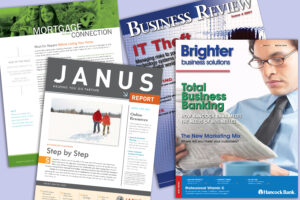I’m a big proponent of the saying, “If it aint broke, don’t fix it.” Just ask my wife. Of course, our definitions of whether something is broken or not aren’t always the same!
There are lots of different ways to market your business, and some are more effective (or not broken) than others. I believe that one of the best marketing tools for practically any business is still the good old-fashioned newsletter.
Benefits of Newsletter Publishing
Newsletters check off a bunch of different marketing boxes. For example:
- They keep your business top-of-mind. Customers and prospects need to remember your business if they want to hire you. By landing in their inbox on a regular basis, you stay top of mind with them so they’re more likely to think of you when they need whatever you sell.
- They position you and your business as experts in your field. Becoming known as a subject matter expert, or SME using industry jargon, is like hitting the marketing jackpot. Your newsletter gives you a chance to share your industry knowledge with customers and prospects who can benefit from it.
- They’re cost-effective. You’d be hard pressed to find a cheaper marketing tool than an e-newsletter. Your only real costs are the content and distribution. And e-newsletters scale really well: It doesn’t cost much more to send one to 10,000 readers than to send one to 1,000 readers.
- They’re easily trackable. Email marketing services like Constant Contact and Mailchimp provide detailed analytics for e-newsletters. This includes who opened and clicked on the email, which links they clicked, which email addresses bounced, who unsubscribed and the percentage of desktop vs. mobile opens.
- They generate content. Your newsletter can serve as your content generation engine and provide the foundation for a broad content marketing program that includes blogs, whitepapers and other content assets.
Tips for Creating Great Newsletters
I have been in the newsletter publishing business my entire professional career, so I’ve learned a few things about how to create a great newsletter. Here are a few of my top tips:
1. Make sure the writing is high quality. This is a no-brainer, right? Not necessarily. It’s shocking how many poorly written newsletters I get, with everything from typos and bad grammar to just flat-out lousy writing.
Your newsletter is a reflection of your business so make sure the writing is top-notch. If you don’t have a good writer on staff, hire a professional to write it for you, or at least edit and proofread your copy.
2. Publish regularly. Frequency is a hot topic of debate in the newsletter world. But the right frequency depends on lots of different factors and varies from one company to the next. For some businesses like retailers, weekly or even daily e-newsletters are fine. For others like most B2B companies, bi-weekly or monthly is usually best.
Decide on the right publishing frequency for your business and then stick to it. I think publishing inconsistently is worse than not publishing at all because it shows a lack of detail-orientation and follow-through on the part of the business.
3. Don’t try too hard to “sell.” A newsletter is a marketing tool, not a sales tool — and there’s a big difference. Sure, you eventually want to sell stuff to your readers, but if you come across as too hard-sell, they won’t read it and will eventually unsubscribe.
Instead, include lots of useful, non-promotional information in your newsletter. That’s what I try to do here in The Writer’s Block. By giving you some helpful writing and marketing tips, I’m hoping you’ll remember me if you ever need to hire a freelance financial writer. That’s about as far as I’ll ever go in making a sales pitch here in the newsletter!
4. Follow some newsletter best practices. For example, people usually decide in two or three seconds whether to open and read a newsletter or not, so you have to write a compelling subject line that captures their attention. Also make sure that your newsletter (and website, for that matter) are mobile-friendly since so many people check their email and browse the web on mobile devices now.
Also use wide margins so there aren’t weird wraps and breaks in the copy. Keep lines at about 55 or 60 characters max and insert hard character returns if a line will be too long or result in a bad wrap. And don’t use ALL CAPS. This is basically the same as screaming at readers, and who wants to be screamed at?
5. Don’t get bogged down in data. Most people today are dealing with information overload. Think about it: A Google search on practically any topic reveals hundreds of thousands, if not tens of millions, of results.
So your goal shouldn’t necessarily be to provide more and better information than the thousands of other sources out there. Instead, try to provide a unique angle or perspective on a topic that readers won’t find anywhere else. This is the best way for your content (and your business) to stand apart from the crowd.
Improve Your Newsletter
If you’re currently publishing a newsletter, think about how these tips could help you improve it. If you’re not, consider how launching a newsletter could benefit your business.

